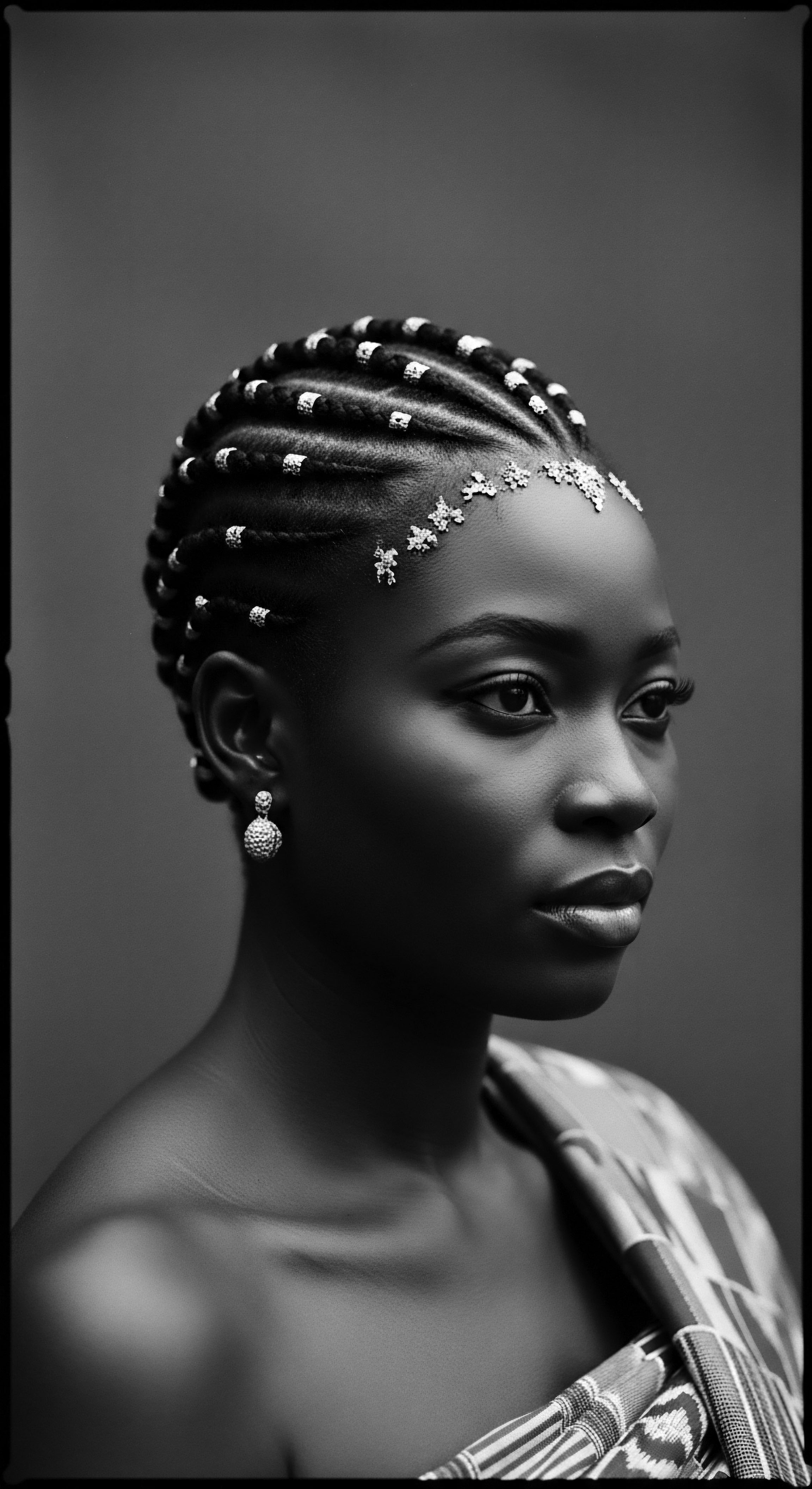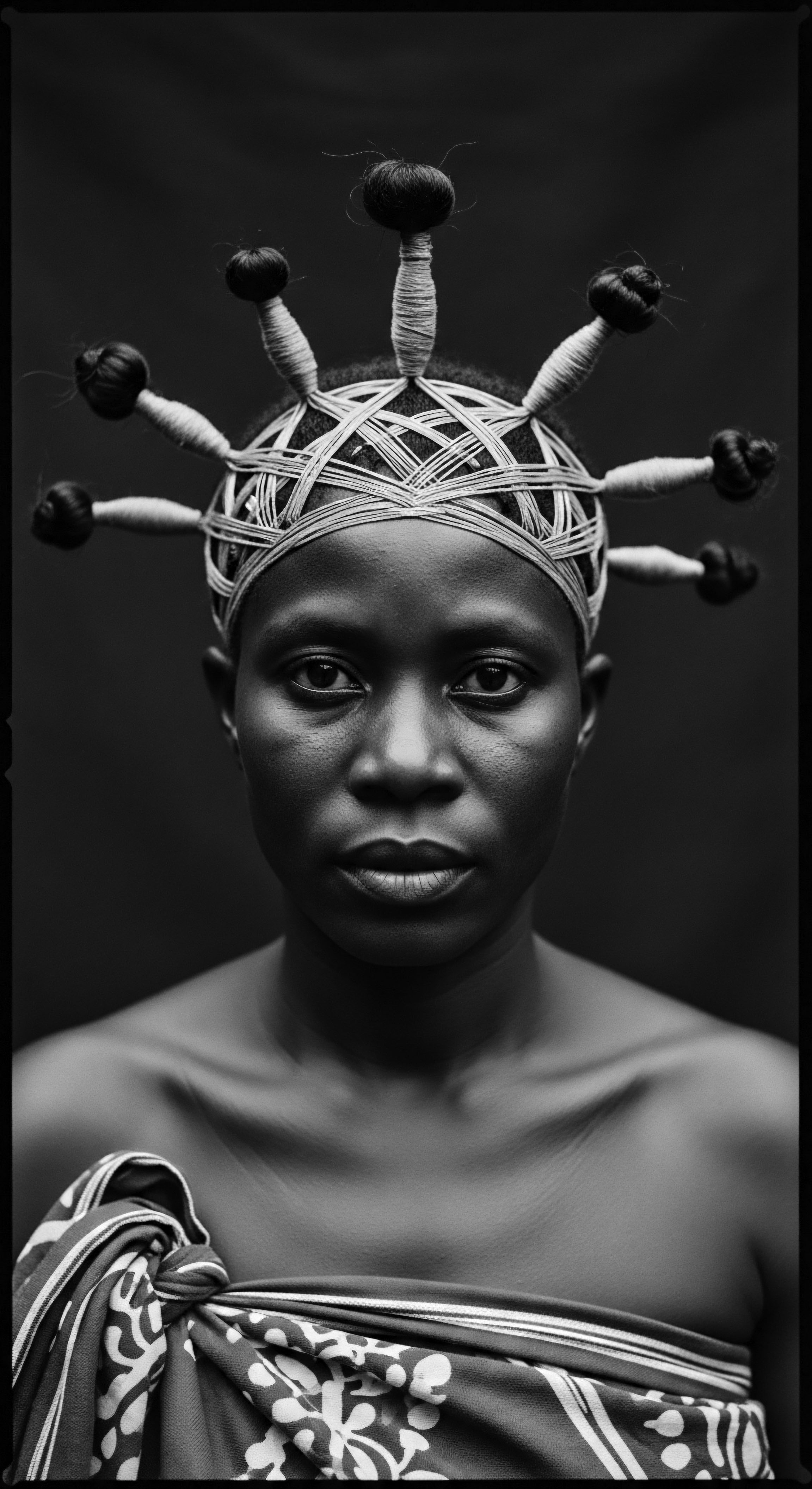
Fundamentals
The spirit of Kente Cloth Symbolism pulses with the rhythmic artistry of West African heritage, particularly among the Akan peoples of Ghana. This woven fabric is far more than a mere covering; it represents a profound visual language, a tangible archive of collective memory. Each thread, every color, and the geometric dance of its patterns communicate layered meanings, speaking of ancestral wisdom, historical events, and philosophical precepts that guided a civilization through time. Its fundamental meaning is a living testament to ingenuity and cultural continuity.
The origins of Kente trace back to the 17th century within the Ashanti region of Ghana. Legend tells of two brothers, Kuragu and Ameyaw, who observed a spider meticulously spinning its web, inspiring them to create the initial form of woven cloth, which they named “Nwin-Ntoma”. This initial inspiration laid the foundation for an art form that would carry the very heart of a people.
Early Kente was woven from raffia palm fibers, eventually evolving to incorporate cotton and, significantly, imported silk threads which added to its renowned vibrancy and luxurious texture. The careful combination of individual strips, each woven separately, forms the complete cloth, revealing a collective effort akin to the communal experiences that bind families and clans.
Kente Cloth Symbolism, at its heart, serves as a visual lexicon, translating the deep philosophical and historical narratives of the Akan people into a wearable testament.

The Language of Color and Form
Kente’s symbolic richness rests heavily on its palette. Each hue conveys a distinct message, capable of expressing nuanced sentiments or historical truths.
- Gold (Yellow) ❉ This radiant shade speaks of wealth, royalty, and spiritual purity, reflecting the sun’s generosity and the preciousness of life’s bounty.
- Green ❉ A representation of renewal, fertility, and the verdant abundance of the land, it brings to mind the cycles of growth and nourishment that sustain communities.
- Blue ❉ This calming color signifies harmony, peace, and deep affection, resonating with the expansive sky and the tranquility of still waters.
- Red ❉ Expressing political and spiritual strength, alongside the profound sacrifices made for liberation, red connects to the vital force of life and passionate action.
- Black ❉ This color embodies maturity, spiritual power, and the accumulated wisdom of ancestors, marking moments of passage and a deep connection to lineage.
- White ❉ A representation of purity, cleansing, and sacredness, white is often chosen for its association with spiritual rites and new beginnings.
These colors, when combined, create dialogues, forming visual poems that can be “read” by those fluent in their traditional grammars. The shapes and geometric motifs within Kente also hold specific designations, each telling a story, reflecting a proverb, or referencing a historical episode. The deliberate arrangement of these elements generates a non-verbal communication system, transmitting societal values and ancestral lessons through generations. It is a living, breathing archive, worn on the body, carrying the weight of history and the aspirations for the future.

Intermediate
Moving beyond the foundational elements of Kente Cloth Symbolism, we begin to appreciate its intermediate layers of meaning, particularly as a reflection of communal identity and an enduring link to ancestral practices. The creation of Kente is not merely an artisanal endeavor; it embodies a process steeped in cultural continuity, echoing the care rituals passed down through generations for textured hair. Just as each strand of hair holds a unique story, each Kente strip carries a piece of a larger, shared narrative.
The names given to various Kente patterns are a direct expression of Akan philosophy, proverbs, and historical events. These names themselves contribute significantly to the cloth’s symbolic depth. Consider, for instance, the pattern known as “Nkyinkyim.” This motif, characterized by a twisted or zigzag path, carries the connotation of life’s winding journey and the different paths one might traverse to reach their destination. It signifies resilience and adaptability, emphasizing that nothing on earth remains static and change is a constant presence.
This symbolism directly parallels the historical journey of Black and mixed-race hair. Through eras of cultural suppression and aesthetic judgment, textured hair has consistently demonstrated its inherent resilience and adaptability, shapeshifting from enforced uniformity to defiant natural expression, a testament to its enduring spirit.

Kente as a Repository of Identity
Historically, the wearing of Kente was reserved for royalty and significant ceremonial occasions, signifying high status, family lineage, and moral values. The complexity of the patterns and the richness of the fabric conveyed the power and prestige of the wearer. This regal association of Kente finds a poignant echo in the ways Black and mixed-race communities have viewed their hair—not merely as a biological attribute, but as a crown, a symbol of dignity, identity, and resistance.
The very structure of Kente, formed from narrow strips meticulously joined, mirrors the collective identity woven from individual histories, much like the communal care that strengthens textured hair heritage.
The communal nature of Kente production also resonates with the ancestral practices of hair care. Traditional African societies often viewed hair grooming as a shared responsibility, a pro bono exchange among family and friends. The process of hair braiding, for example, was a profound act of bonding and communication, transmitting knowledge, stories, and social values.
This mirrors the careful weaving of Kente strips, where the hands and minds of artisans come together to create a unified, meaningful textile. The shared experience in creation and adornment reinforces a sense of collective belonging and strengthens cultural ties.
The gradual shift in Kente’s accessibility, from exclusively royal regalia to broader usage in ceremonies and special events, reflects a democratizing of its symbolic power while retaining its core cultural significance. Similarly, the journey of textured hair, from being a source of shame or concealment under colonial and post-colonial pressures to its modern reclamation as a source of pride and self-affirmation, represents a powerful reassertion of identity. Both Kente and textured hair have served as visual languages, communicating complex social, spiritual, and historical realities across generations.
| Aspect of Symbolism Status Marker |
| Kente Cloth Historical Context Originally worn by Akan royalty and chiefs to signify power, wealth, and authority. |
| Textured Hair Heritage Parallel Traditional hairstyles indicated age, marital status, and social standing within African societies. |
| Aspect of Symbolism Proverbial Wisdom |
| Kente Cloth Historical Context Patterns like "Nkyinkyim" embody proverbs about resilience and life's complexities. |
| Textured Hair Heritage Parallel Hair styles communicated spiritual beliefs, tribal identity, and philosophical outlook. |
| Aspect of Symbolism Adaptability |
| Kente Cloth Historical Context Evolution from raffia to silk and cotton, adapting to new materials while retaining core meaning. |
| Textured Hair Heritage Parallel Adaptation of hair care practices and styles in response to migration and societal pressures (e.g. protective styles, natural hair movements). |
| Aspect of Symbolism Both Kente and textured hair demonstrate a remarkable ability to carry and transmit cultural memory, adapting their forms while holding firm to their historical roots. |

Academic
The academic elucidation of Kente Cloth Symbolism requires a scholarly approach, dissecting its semiotic structures and its profound role as a socio-cultural artifact. Kente operates as a complex system of communication, wherein each visual element—color, pattern, and composition—functions as a signifier, collectively producing a rich tapestry of signified meanings that are deeply embedded in Akan cosmology, history, and social organization (Blier, 1998). The cloth’s definition extends beyond its material composition, reaching into the very core of identity formation and collective consciousness within the Akan linguistic group and across the broader African diaspora. Its design principles are rooted in centuries of observation, philosophical reflection, and the meticulous transfer of knowledge, making it a subject of rigorous anthropological and art historical inquiry.
The nomenclature of Kente patterns, such as “Nkyinkyim,” which signifies a twisted, non-linear path, serves as a powerful illustration of this symbolic depth. This pattern encapsulates the concept of navigating life’s challenges with resilience and cunning, a notion that resonates with the Akan proverb, “Life is a journey, not a straight path”. Such patterns are not merely decorative; they are mnemonic devices, designed to transmit ethical guidelines, historical narratives, and philosophical insights from one generation to the next. The very act of wearing a Kente cloth thus transforms into a performative utterance, a public declaration of allegiance to shared values and an acknowledgment of a collective heritage.

Kente Symbolism and Textured Hair ❉ An Interwoven Semiotic Landscape
The connection between Kente Cloth Symbolism and textured hair heritage reveals a fascinating parallel in their semiotic functions and their shared role as powerful markers of identity and resilience within Black and mixed-race communities. Both Kente and textured hair have endured periods of systemic denigration, yet both have consistently been reclaimed as symbols of ancestral strength and self-determination. The ability of Kente to convey intricate narratives through its visual language is mirrored in the historical practice of hair styling among African peoples, where coiffures communicated marital status, social standing, age, and even served as maps for escape during periods of enslavement (Byrd & Tharps, 2014; Caldwell, 1991).
Consider the historical example of hair braiding in the African diaspora, which functioned as a vital mode of communication and preservation of cultural heritage during the Transatlantic Slave Trade and its aftermath. Enslaved Africans, stripped of their material possessions and often forbidden from speaking their native tongues, utilized their hair as a covert medium for transmitting information and maintaining spiritual connections. For instance, rice grains or seeds were braided into hair before the perilous Middle Passage, serving as a desperate means to carry sustenance and a promise of continuity.
Further, intricate cornrow patterns were strategically designed to represent topographical maps, providing pathways to freedom for those seeking to escape bondage. This systematic and purposeful encoding of information within hair, transforming it into a living blueprint for liberation, embodies the “Nkyinkyim” principle of adaptability and navigating complex, challenging journeys, much like the symbolic zigzags of the Kente pattern itself.
This historical reality underscores a profound shared characteristic ❉ the transformation of ordinary elements—fabric and hair—into potent symbols of cultural survival and agency. The deliberate artistry of Kente weaving and the meticulous skill of traditional hair braiding both represent an embodied knowledge system, passed down through apprenticeship and observation, preserving traditions when formal instruction was impossible. This mirrors the findings in Sieber and Herreman’s work (2000), which underscores the enormous significance of hair in African art and life, noting its role as an indicator of age, authority, social status, and religious affiliation, as well as a medium for aesthetic adornment. The very act of care, whether for the Kente loom or for the coiled strand, becomes a ritualized practice of connection to ancestral wisdom.

The Socio-Psychological Impact of Symbolic Reclamation
The persistent socio-political implications surrounding textured hair in the diaspora, as explored by scholars like Emma Dabiri (2020), further deepens this understanding. Dabiri’s analysis highlights how Black people’s relationship with their hair is deeply meaningful, moving beyond mere aesthetics to represent a struggle for self-acceptance and a rejection of Eurocentric beauty standards. The contemporary natural hair movement, therefore, functions as a modern manifestation of the “Nkyinkyim” spirit—a powerful assertion of identity that navigates the winding path of historical discrimination and societal pressures.
The choice to wear natural hair, adorned with styles that echo ancestral techniques, is a conscious act of cultural reclamation, akin to adorning oneself in Kente cloth at a formal gathering to signify a commitment to heritage. This collective affirmation of natural hair forms a visible, public declaration of identity, much like the Kente cloth’s declarative presence in ceremonial spaces.
The symbolic resilience embedded within Kente Cloth Symbolism finds a mirror in the enduring strength of textured hair. Both have served as a “barricade” or a “thunder of power”—meanings also linked to specific Kente pattern components as described in the Kwame Nkrumah Kente design. This signifies a protective, empowering quality. The meticulous care, whether applied to the weaving of Kente or the tending of hair, becomes a holistic practice, uniting the physical and spiritual aspects of well-being.
The philosophical understanding embedded within Kente, that life’s journey is multifaceted and demands adaptation, applies seamlessly to the historical and contemporary experiences of individuals with textured hair, who continually adapt their practices and expressions to reflect their dynamic realities. The intricate dance of pattern creation in Kente mirrors the skilled hands that transform diverse hair textures into expressions of art, dignity, and collective memory.
- Historical Context of Reclamation ❉ During periods of cultural suppression, both Kente and traditional hair styles were often marginalized or forbidden. Their re-emergence signifies a powerful reclaiming of identity and ancestral connections.
- Communal Knowledge Transmission ❉ The detailed knowledge required for Kente weaving, passed down through generations, directly corresponds to the oral and embodied transmission of hair care practices and styling techniques within families and communities.
- Resilience as a Core Meaning ❉ The “Nkyinkyim” Kente pattern’s interpretation of adaptability resonates strongly with the historical journey of Black and mixed-race hair, which has survived and transformed through periods of oppression and cultural shifts.

Reflection on the Heritage of Kente Cloth Symbolism
The enduring legacy of Kente Cloth Symbolism continues to resonate deeply within the spiritual architecture of textured hair heritage and its communities. From the rustle of its meticulously woven strips to the quiet strength it lends those who wear it, Kente stands as a living testament to ancestral wisdom, a profound declaration that identity is not merely inherited, but actively crafted, cared for, and celebrated. It embodies the notion that true beauty stems from authenticity and a conscious connection to one’s roots, a sentiment that aligns perfectly with the ethos of tending to textured hair as a sacred act of self-reverence.
The interplay between Kente’s patterned language and the expressive power of hair reminds us that our bodies, our adornments, and our practices are all canvases for cultural meaning. Just as the master weaver selects threads to compose a story, we, through our hair choices and care rituals, are continuously authoring our own narratives, honoring those who came before us. This continuous dialogue with history, expressed through tangible forms like Kente and the vibrant expressions of textured hair, ensures that the wisdom of the past remains a guiding light for future generations.
In observing Kente, one senses the generations of hands that labored, the minds that conceived, and the spirits that infused meaning into each design. This mirrors the hands that have tenderly nurtured coiled strands through time, through joy and sorrow, celebrating the unique texture and the rich heritage it carries. The symbolism of Kente invites a pause, a moment of deep introspection into the interconnectedness of our cultural expressions and the enduring spirit that binds us across time and space. It confirms that the journey of self-discovery, particularly through the lens of hair and heritage, is a continuous act of affirmation, a beautiful, textured unfolding of ancestral narratives.

References
- Blier, Suzanne Preston. The Royal Arts of Africa ❉ The Majesty of Form. New York ❉ Harry N. Abrams, 1998.
- Byrd, Ayana D. and Lori L. Tharps. Hair Story ❉ Untangling the Roots of Black Hair in America. New York ❉ St. Martin’s Press, 2014.
- Caldwell, Paulette M. “A Hair Piece ❉ Perspectives on the Intersection of Race and Gender.” Duke Law Journal, vol. 41, no. 2, 1991, pp. 365-397.
- Dabiri, Emma. Twisted ❉ The Tangled History of Black Hair Culture. New York ❉ Harper Perennial, 2020.
- Ellis, Alfred B. The Tshi-Speaking Peoples of the Gold Coast. London ❉ Chapman & Hall, 1887.
- Gillow, John. African Textiles. London ❉ Thames & Hudson, 2009.
- Ross, Doran H. Wrapped in Pride ❉ Ghanaian Kente and African American Identity. Los Angeles ❉ UCLA Fowler Museum of Cultural History, 1998.
- Sieber, Roy, and Frank Herreman. Hair in African Art and Culture. New York ❉ Museum for African Art, 2000.
